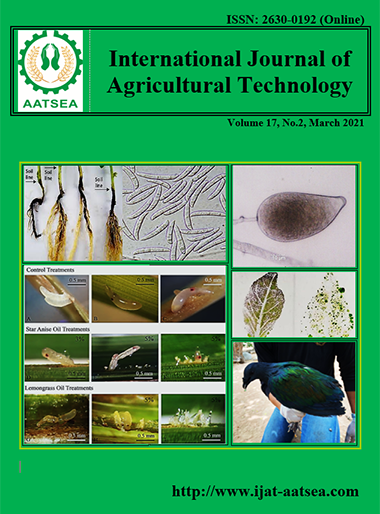Resilience, various benefits, and constraints of rubber agroforestry systems in southern Thailand
Main Article Content
Abstract
The research finding found various margin resilience of the twelve rubber agroforestry plots, classified by resilience levels: 1) five plots with the high resilience; 2) six plots with the medium resilience; and 3) one plot with the low resilience. Timbers in rubber plots showed the high resilience and the plots had timbers left for income generation in the future. Duck and goat in rubber plots had flexible resilience. Also, they kept weeds in check by eating them and their feces acted as organic fertilizers. The sarjor-caju mushroom, vegetable fern, and straw mushroom under rubber plots generated the top three margins in 2019 and green products. Gnetums under the shade of rubber trees grew well and produced good-tasting leaves. Pineapple and sala under rubber trees grew well and were good quality fruits. However, mangosteen and longgong under rubber trees were characterized taller shapes with less harvesting than the typical monoculture. The recommendations for promoting rubber agroforestry suggested to practice in the future: 1) cut down stunted and diseased rubber trees and intercropped trees that cannot be harvested or in the case of new rubber plantings, expand rubber inter-row distances, to allow more sunlight into the plots and decrease competition of root system, 2) prune fruit intercrops to allow more sunlight entry and control the canopy, 3) choose a kind of intercrop suitable for the ecosystem in the plot and 4) choose kinds of intercrop appropriate to the farmer’s time availability, and need for income.
Article Details

This work is licensed under a Creative Commons Attribution-NonCommercial-NoDerivatives 4.0 International License.
References
Chiarawipa, R. (2019). Rubber-based Intercropping System in Southern Thailand: Its Constraints and Planting Patterns on Sustainable Productivity. King Mongkut’s Agricultural Journal, 37:179-189.
Darnhofer, I. (2009). Strategies of Family Farms to Strengthen their Resilience. The 8th International Conference of the European Society for Ecological Economics, June 2009. Slovenia.
De Leeuw, J., Njenga, M., Wagner, B. and Iiyama, M. (editors). (2014). Treesilience: An assessment of the resilience provided by trees in the drylands of Eastern Africa. Nairobi, Kenya: ICRAF.
Delarue, J. and Chambon, B. (2012). Thailand: first exporter of natural rubber thanks to its family farmers. Économie rurale, n°330-331:191-213.
Holling, C. S. (1973). Resilience and Stability of Ecological System. Annual Review of Ecology and Systematics.
Hu, B. (2019). hubch@cass.org. cn. Personal interview.
Jongrungrot, V. and Thungwa, S. (2013). The functional structure of a rubber-based agroforestry system. Thai Journal of Forestry, 32:1233-133.
Jongrungrot, V., Thungwa, S. and Snoeck, D. (2014). Tree-crop diversification in rubber plantations to diversify sources of income for small-scale rubber farmers in Southern Thailand. Bois et Forets des Tropiques, 68:21-32.
Kheowvongsri, P. (2008). Principle of agroforestry. Songkhla: Department of Earth Science, Faculty of Natural Resources, Prince of Songkla University.
Langenbergerb, G., Cadisch, G., Martin, K., Min, S. and Waibel, H. (2016). Rubber intercropping : a viable concept for the 21st century? Retrieved from https://link.springer.com/content/pdf/10.1007/s10457-016-9961-8.pdf.
Lin, B. B. (2011). Resilience in Agriculture through Crop Diversification: Adaptive Management for Environmental Change, BioScience, 61:183-193.
Office of Agricultural Economics (2019). Agricultural Statistics of Thailand 2018. Retrieved from http://www.oae.go.th/assets/portals/1/ebookcategory/27_year book2561/# page=1.
Pierret, A., De Rouw, A., Chaplot, V., Valentin, C., Noble, A., Suhardiman, D. and Drechsel, P. (2011). Reshaping upland farming policies to support nature and livelihoods: Lessons from soil erosion in Southeast Asia with emphasis on Lao PDR. Marseille, IRD and Colombo: IWMI.
Sdoodee, S. and Limsakul, A. (2012). Impact trend of climate change on Rubber Plantation in Southern Thailand. In:Inter-gration of Climate Change Research Knowledge into National Sustainable Development Policy Conference. June 22, 2012. Muangthongthani, Bangkok, Thailand.
Simien, A. and Penot, E. (2011). Current evolution of smallholder rubber-based farming systems in Southern Thailand. Journal of Sustainable Forestry, 30:247-260.
Siriaraya, S. (2009). Smallholder rubber plantations dynamics and policies to support them. In: Lessons learnt from the Support Program to rubber smallholder plantations. Phnom Penh, 24 June 2009, 12 slides.
Somboonsuke, B. and Wettayaprasit, P. (2013). Agricultural system of natural Para Rubber smallholding sector in Thailand. Extension and Training Office (ETO), Kasetsart University.
Stroesser, L., Penot, E., Michel, I., Tongkaemkaew, U. and Chambo, B. (2016). Income diversification for rubber farmers through agroforestry practices: How to overcome rubber prices volatility in Phatthalung province, Thailand. Revue internationale des études du développement, 3:117-145.
The World Bank (2019). World Bank Commodities Price Forecast. Retrieved from http://www. worldbank.org/prospects/commodities.


